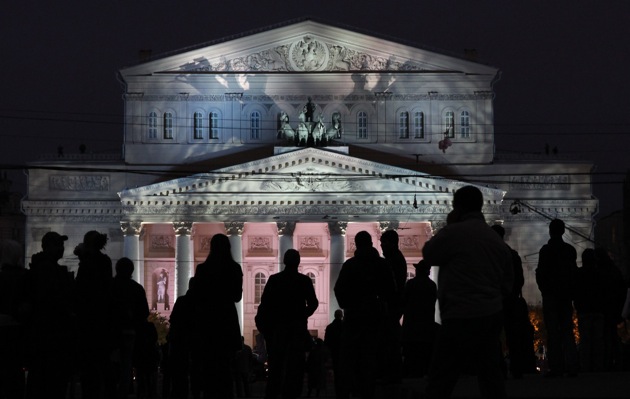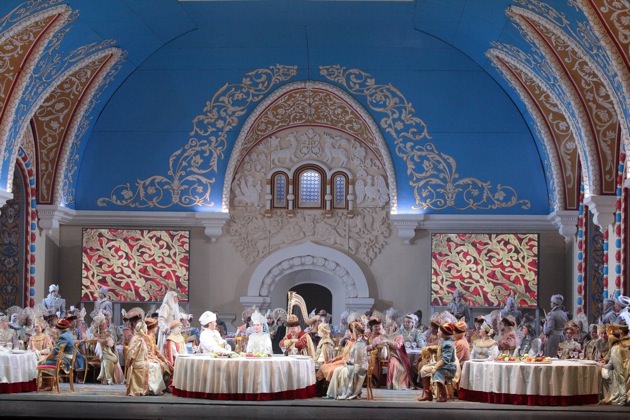On July 1, 2005, just before it closed for renovation, Moscow’s Bolshoi Theater staged a final performance of two Russian classics: Tchaikovsky’s ballet Swan Lake and Musorgsky’s opera Boris Godunov. Like the Bolshoi itself, these two works have, over the course of their long histories, accrued heavy political baggage. The ballet was shown on state television during the failed Soviet coup d’état of 1991. And the opera, which pits an illegitimate czar against a pretender to the throne, found nightmarish parallel in the struggle for control between Gorbachev and Yeltsin during the eerie final months of Soviet power.
A gala celebration two weeks ago of the $680 million-plus restoration of the Bolshoi was a political event of a different order. On October 28, the current ruling class basked in the gleaming result of its largesse—never mind the repeated construction delays, the resignations of people in charge (including the former mayor of Moscow Yuriy Luzhkov), and the rumored embezzlement by contractors of huge sums that were spent on private dachas. President Dmitri Medvedev attended with his wife and son, as did Mikhail Gorbachev, his granddaughter, the Patriarch of the Russian Orthodox Church, billionaire oligarchs, Russian fashion and film icons, state television reporters, and those who could afford to purchase invitations online for a purported 2,000,000 rubles ($66,500).
Both the closing and the reopening of the theater point to how much the Bolshoi has been, and still is, a central part of Russian life. The theater is as old as the United States, and seems to have lived through nearly as much. It burned down three times between 1776 and 1856. Following the 1917 revolution, the Bolsheviks denounced the Bolshoi as a decadent symbol of the Russian imperial past and considered detonating it; instead the repertoire of the State Academic Bolshoi Theater, as it became known, fell under Communist Party control. During World War II, part of the foyer was destroyed by a 1,000 pound German bomb; it was repaired on the postwar cheap. The acoustics had already been wrecked by Stalin, who ordered the czar’s loge at the center of the first tier encased in protective cement.
Through it all, performing at the Bolshoi—whether for an audience of politburo members or the proletariat—remained the crowning achievement of a career. Its artists received larger salaries, and bigger perks, than anywhere else within Soviet Russia or its satellite republics. When the Soviet Union disintegrated, however, so too did the Bolshoi. Standards precipitously declined, singers and dancers went on strike, then headed abroad; the basement flooded. The outer walls began to look diseased. The theater, having once been a point of national pride, became a national disgrace. By 2005, with the Kremlin’s coffers full of petro-rubles, restoring the theater to its former glory—and beyond—became a pressing matter.
In the run-up to the reopening, the staff of a newly created federal agency devoted solely to the theater’s restoration dazzled journalists with tales of miracle-working artisans. I was impressed to learn about the demineralization of the limestone columns, which removed a century of city grime to uncover a matte, milky white surface. The theater issued a scandal-free account of the project full of staggering statistics: 2,812 sheets of 960 carat gold leaf were applied across the auditorium; 24,000 pieces of crystal were polished, refashioned, and rehung in the chandelier. The result is meant to overwhelm, and it certainly does. In his opening remarks from the stage at the gala, a slightly nervous-looking Medvedev observed that Russia, vast as it may be, was “very limited” in terms of “the number of unifying symbols, national treasures, of so-called national brands.” The Bolshoi is now clearly the preferred brand, the Kremlin’s designer label.
No wonder the director of the high-pressure gala, Dmitri Chernyakov, an iconoclast much beloved by the Moscow theatrical establishment, chose to stage the reopening of the Bolshoi itself: he showcased the process of the renovation along with its product. The curtain opened to reveal a noisy, dusty construction scene. Slowly members of the Bolshoi chorus, dressed as workers, gathered at the proscenium to perform the anthem “Be Glorious, Russia!” to onstage brass accompaniment and the pealing of Orthodox bells. No fewer than six works by the imperial Russian composer Tchaikovsky were performed by in-house and guest artists. Next in line came Glinka and Prokofiev, with works two each. The first of these two composers has been mythologized as the father figure of Russian music; the second spent the first half of his career in the West, but then nostalgically decided to return to Russia—though he arrived at a very bad time, the beginning of the Stalinist Terror. Medvedev applauded politely throughout, but did not respond after the French soprano Natalie Dessay sang Rachmaninoff’s setting of Pushkin’s lyric, “Ne poy, krasavitsa.” The text refers to Georgia—no friend of Russia these days.
Advertisement
Russia’s current prime minister and future president, Vladimir Putin, was not in attendance. No one in Moscow was surprised. Apparently Medvedev had moved up the date of the theater’s reopening to ensure that it took place during his administration, even though the renovation is not entirely finished. During rehearsals for the first opera production a few days later, the conductor Vladimir Jurowski was busy listening to the pinewood interior of his new hall, trying to refine its sound. Jurowski, elegant and enchanting on the podium, is hugely in demand throughout Europe and North America, and the Bolshoi worked hard to secure his services at the helm of its orchestra. He did not conduct the gala (the task fell to Vassily Sinaisky) but was in the audience. I asked him about the acoustics in the czar’s loge, where he sat by request of Bolshoi Theater administrators. “Terrible,” he replied. “And they put me behind Medvedev.”
Jurowski was on the podium for the public opening of the theater on November 2. For years everyone assumed that Glinka’s opera A Life for the Tsar would be the pick for this second epochal evening. An optimistic tragedy that pits a self-sacrificing Russian against invading Poles, it’s the Russian opera, having even been blessed as such by nationalist ideologues during the Soviet era. Performing it at the reopening would be, many thought, an allegorical affirmation of Russia’s imperial resurgence after the chaotic Yeltsin years.
But circumstances changed. Somewhere along the chain of command from the Ministry of Culture and Mass Communications to the Board of Trustees of the Bolshoi Theater, right up to its General Director, Glinka’s first opera was scratched in favor of his second, Ruslan and Lyudmila, a fairytale for adults based on a brilliantly licentious and lewd narrative poem by Alexander Pushkin. Perhaps its happy ending explains why it was chosen over Glinka’s aggressively anti-Polish first opera. Or perhaps offending Poland is no longer politically expedient, especially not since the airplane crash outside Smolensk that killed President Lech Kaczynski in April 2010.
I attended the dress rehearsal and premiere, after roaming the theater grounds and witnessing the pushing and shoving in a queue for tickets three months out. The cynicism in the unofficial press about the Kremlin-scripted reopening celebration evidently did not dissuade Moscow’s throngs of opera and ballet lovers from seeking seats. Inside, Chernyakov, the director, faced a daunting creative challenge: Jurowski had decided to conduct the entire score, without cuts—all five hours.
Chernyakov not only anticipated a hostile public reaction, but even built it into the staging. I half expected a poor review to appear in the supertitles. Elaborate, almost life-sized puppets lampooned a choral round dance in the first scene. The otherwise poignant death of a warrior took the form of an interrupted video transmission. The sorceress Naina mocked the hecklers in the crowd before exiting in a sable coat that concealed the cast on her arm. (She took a fall in Act I, and the bone was set during an especially lengthy intermission.)
While most of the critics loved the result, the public was divided, with cries of “pozor” (shame) raining down on the performers after the racier third and fourth acts. The elderly ladies in front of me shook their heads in disgust at the sight of a muscle-bound character dancing a lezginka—a theatrical nod to the licentious opulence of the Azeri-operated Crocus City Mall on the edge of Moscow. There was whistling during the entr’actes when videos were projected onto a lowered screen from those who felt that 5,000 rubles ($165) was too steep a price for a trip to a multiplex. Some who left before the end expressed their disapproval by slamming the restored back doors of the restored loges. Three quarters stayed and cheered.
There were two masterstrokes. The first was Jurowski’s conducting, which highlighted, through delicate contrasts in tempo and timbre, the places where Glinka borrowed his vaunted “Russian” music from Italian composers like Bellini, Donizetti, and Rossini. (Like so much supposedly nationalist music, the score is actually quite cosmopolitan, a stylistic mélange.) And by thinning out the strings and keeping the brass in check, Jurowski returned to a lighter, antique texture more in keeping with Glinka’s original intent.
The second was the sumptuously stylized historical décor of Acts I and V, in which Chernyakov provided the audience with the exotic Russia of its imagination: an impossibly bright czarist mansion in blue and gold; beards and braids reaching down to the knees; outrageously over-embroidered folk garb just back from the cleaners. The set looked like the inside of a Faberge egg. Russian directors used to stage Slavic kitsch of this sort for foreign crowds in Paris and London; now, evidently, it’s desired at home. The production seemed innocent enough until the end of the first scene, at which point characters started turning up in 21st century gowns and tuxedos. Lyudmila was rolled up in an oriental rug and carted off.
Advertisement
Should the example set by this premiere become a trend, the Bolshoi Theater will cease being the bearer of moribund tradition. Finally, the old cultural symbols will have been retired. This is a good thing for Moscow, a sprawling city whose center has become a nationalist theme park, with historical buildings like the glowering Stalin-era Moskva Hotel demolished and replaced with unconvincing copies. Clearly Russian oligarchs wanted the new-old Bolshoi to add to the amusements. But the gala is over, and the artists who make their living on the boards of Cavos’s Grand Theater—a group that now includes foreigners such as the American lead dancer David Hallberg—have other ideas. The Bolshoi hasn’t been restored at all. Beneath the gilt and glitter, it has been transformed into a fantastically unpredictable space.





